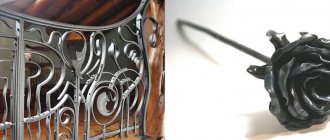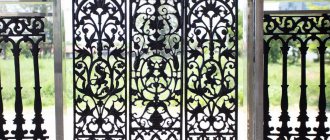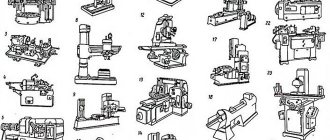Artistic metal processing is in some way the work of a creative direction. Long known, dating back to ancient times, this activity is not for nothing called the art of small forms. As a result of the use of the skills and talents of the craftsman, the material from which the product is further produced acquires greater expressiveness, not without aesthetic value. It is worth noting that this art began with gold processing, but gradually moved to a wider range of materials and even alloys.
Types and characteristics of metals
The key to a successful job is knowledge of the characteristics and qualities of the material, its technological and working properties. Thus, when working with metals, both pure raw materials, without additional impurities, and various alloys are used. Materials used in production are divided into two main groups:
- black;
- colored.
Main types of materials used:
- Carbon steel is an elastic metal with the ability to harden. The steel is well forged and cut, and is produced as a long product. When making steel products using artistic processing, grades U8 and U10 are used.
- Copper is a soft, malleable, reddish material, easy to work, but somewhat ductile. Copper is highly solderable, conducts electricity and heat, and is often used to make art products.
- Bronze is a compound of copper and tin. The use of bronze is practiced in casting and inlay.
- Brass is an alloy of zinc and copper, a harder and less malleable material than copper. Brass is easy to process and is suitable for inlaying and embossing.
- Zinc is a white metal with a bluish tint. The material is difficult to forge, but is convenient for soldering and easy to process. Zinc is often used in engraving and casting.
- Tin is a soft, white material. Tin is used for tinning and inlaying, and comes in a variety of alloys.
- Aluminum is a lightweight material that can be easily processed.
- Lead is a soft metal that does not oxidize easily and is often used for casting. Lead oxide is extremely poisonous.
- Silver. Outside of alloys, it is rarely used due to excessive softness, therefore, in finished products, most often there is an alloy of silver and copper. Silver is also used when carrying out inlay work.
Artistic metal processing
Profile disciplines
The training program focuses on the following subjects:
- drawing;
- painting;
- composition;
- computer design;
- Industrial Design;
- sculpture and modeling;
- 3D visualization;
- development and creation of artistic objects;
- artistic processing technology;
- artistic materials science.
Students undergo practical training at the department and in the laboratories of the university, as well as in production. Research work must be included in educational practice.
Characteristics of metals
Qualities inherent in metals:
- The fragility of a material is the opposite quality of plasticity, which in practice means the ability to quickly self-destruct under external mechanical influence. Thus, overheated steel, cast iron and bronze easily split into pieces.
- Elasticity is a feature that means the restoration of shape and volume when external influences cease. To the greatest extent, these properties are inherent in individual grades of steel.
- Fusibility is the ability of a metal to transform into a liquid state when heated. Fusibility is widely used in both industrial and handicraft production of metal products.
Skills
Graduates of higher educational institutions are ready for independent work.
Their knowledge allows you to:
- Select the most optimal material for the manufacture of products, taking into account its characteristics and operational features.
- Determine the properties of materials visually and using physical and chemical analysis.
- Develop modern technologies for processing materials and introduce them into the technological process.
- Independently choose tools and equipment for the production of industrial and artistic objects.
- Monitor product parameters, production process, quality of materials.
- Invent and create sketches of objects.
- Engage in restoration.
- Select materials taking into account their artistic compatibility.
- Evaluate the aesthetic value of a particular product, guided by artistic criteria.
- Make compositions from different materials.
- Design objects from materials of different groups.
- Participate in the design of small-scale production sites.
- Head the design department at the enterprise, organize and supervise the work of subordinates.
Metal processing operations
Metal processing is a mechanical action that allows you to change the physical state of the material. The main purpose of processing is to produce products necessary for everyday life, as well as luxury goods or works of art.
Artistic processing, in contrast to the industrial production of metal products, is the skill of making things that satisfy the aesthetic, creative principle in a person. The manufacturing process produces products that have sophistication, expressiveness and artistic value.
Metal art
The following are considered to be the types of artistic metal processing:
- casting;
- forging;
- minting;
- metal-plastic;
- engraving;
- etching;
- filigree;
- enameling.
Casting is an ancient processing method
The casting method is associated with the fusibility of the metal, a quality that occurs when the material is exposed to heat. The liquid material obtained as a result of melting is poured into the required, pre-prepared forms. After cooling, the castings are used as finished products or as an integral part of the main product.
The casting mold is prepared before the main work begins. If the poured product has a complex structure, several molds are prepared, and the parts obtained as a result of casting are connected to each other.
Casting is divided into:
- for casting metal - cast iron, copper, silver or gold.
- on the design and material of the molds. Temporary forms - sand, earth; shell. Stationary molds made of wax, plaster or metal.
- by casting method: centrifugal, under pressure, standard.
The metal is melted in special furnaces. Since the melting point of different materials differs, in the absence of a mechanism for fixing the temperature, visual control of the process is necessary. After melting, the metal is poured into molds, the workpieces are allowed to cool, then cleaned and polished.
Types of mechanical influences
The essence of artistic metal processing is to perform a number of technological operations leading to a change in the physical state of the materials.
The method differs in all respects from industrial production. It opens up the opportunity to receive not just faceless stamped dishes, but utensils or interior items that have an aesthetic component. Products made by hand by craftsmen have a strong personality and poetic expressiveness.
Types of artistic metal processing include:
- casting;
- minting;
- forging;
- chemical etching;
- metal-plastic;
- engraving;
- scan
Casting
This ancient method involves pouring molten metal into specially prepared molds. It allows you to produce complex, elegant products that are close in appearance to sculptures. What they have in common with marble or plaster statues is an amazing accuracy in conveying the smallest details.
When it is necessary to create particularly bizarre or multifaceted compositions, several sand casting molds are prepared, which are subsequently connected to each other. Professional furnaces are used for smelting. At the end of the work, the molds are cooled, cleaned and polished.
Forging
Along with casting, it is considered one of the most ancient methods of artistic metal processing. The prepared workpiece is subjected to deformation using forging hammers. There are hot and cold forging. The first option is considered more popular and effective. It is more suitable when working with low carbon steels.
Precious metals are well forged using the cold method. Under the blows of a hammer, silver or gold, as well as copper, change their shape. Plasticity disappears, as a result of which the density increases. This process is called cold hardening. Immediately after this, a stage such as annealing is carried out, accompanied by recrystallization.
Coinage
This type of artistic metal processing means the creation of a relief image on the surface of the material, without changing its thickness. Point pressure is applied to metal objects using hammers, punches and other professional tools. As a result of repeated blows, a pattern is formed, each smallest element of which repeats the shape of the tip of the hammer.
The coins differ significantly from each other. Experienced craftsmen use entire groups of shaped devices, ranging from canfares to circuses.
Metal-plastic
This artistic metal processing is quite similar in appearance to conventional minting. The differences lie in the process of creating the design, and above all in the thickness of the tin sheets used. Very thin metal plates are selected (no more than 0.5 mm). They resemble foil straightened from rolls. Special stacks are used that resemble sculptor's tools.
In general terms, the workflow consists of the following steps:
- Annealing of workpieces (except tin). The tape is heated gently until a slightly brown heat appears. Then the blank is slowly cooled.
- A previously prepared paper drawing saved on tracing paper in a mirror image is transferred to the processed material. After the annealing procedure, an oxide layer is formed on it, which perfectly perceives the image.
- The contours are outlined in a stack. A piece of flat linoleum is most often used as a substrate. The plate with the sketch is transferred to a glass table, where the background is leveled and auxiliary lines are drawn.
Using metal-plastic, you can decorate furniture elements, wooden interior items, doors, etc.
Engraving and etching
A widespread technique of artistic metal processing. A linear picture or a relief sketch is applied using a special cutter. The work is performed using planar or armor methods. They are also called two-dimensional and three-dimensional, respectively.
In the first case, the surface of the finished product is decorated. These can be images, memorial inscriptions, ornaments. Volumetric engraving consists of forming a relief or even a separate figure.
In addition, experts also include etching as this type of artistic metal processing. There are chemical and galvanic options. The electrical method is considered less toxic. When using an acid or alkaline bath, the necessary sectors on the product are pre-coated with an ultra-resistant varnish that is impervious to the action of aggressive substances. Unprotected areas are eaten away, forming a given pattern.
There are also more complex, specific methods of artistic metal processing, which include filigree and enameling. Work on creating filigree is carried out exclusively by highly qualified artists and jewelers.
Coating metal with enamel is an inexpensive method of effectively transforming dishes and objects. The surface of copper, silver or other precious metals is covered with a layer of molten glass with special properties. Currently, multi-colored semi-finished enamel products in the form of briquettes or powders are produced at industrial enterprises.
How to forge metal products
Forging is an ancient method of metal processing. The essence of the process is to give the workpiece the desired shape using hammer blows. Under the blows of the hammer, the part is deformed and gradually takes on the desired shape.
The property of a metal that ensures “correct” deformation, without cracks or breaks, is called ductility. Malleability, in most cases, is inherent in precious metals, which have ductility and toughness.
Metal forging
Features of cold forging
The history of artistic metal processing tells us about the “cold forging” method, which was widely used in Kievan Rus. Through “cold forging”, goldsmiths forged bowls, ladles, etc. from ingots of precious metal.
The blacksmith's task, at the first stage of work, was to compact the product under the blows of the hammer. On the second stage, the processed metal was subjected to annealing, grinding, etc. Nowadays, this method is used only in jewelry.
Difovka is considered a type of cold forging, which means artistic processing of sheet metal up to 2 mm thick. This method was used in Ancient Greece by the greatest sculptors of the ancient era, Phidias, who created golden clothes for statues of gods.
Forging
Processing heated metal with a hammer is forging, and it is also the oldest method. Under uniform blows of the hammer, the metal workpiece gradually acquires the required appearance, however, alloys of different compositions behave ambiguously during forging - cracks and breaks appear.
Hot forging - deformation of hot metal with a hammer
The degree of malleability of the metal to such processing is measured in the value of malleability. Depending on this parameter, a distinction is made between cold and hot forging.
Precious and non-ferrous metals (gold, silver, copper) are soft enough that they can be processed by cold forging.
Table of melting points of the most common metals
Iron and alloys based on it can be forged only in a heated state. Heating occurs in a special furnace to a temperature of 1000°C, then the metal can be deformed, bent, and, in general, given the desired shape.
Based on the principles of forging, an artistic processing technique was developed - cutting. It consists in giving the sheet of metal an openwork appearance.
Cold forging is changing the shape of a product by hammer blows of varying strength. As a result, the metal quickly loses its ductility, becomes compacted, and hardening appears. The next step is annealing, which is used to remove the formed hardening.
In modern conditions, cold forging is often used in the jewelry industry.
Handmade artistic metal forging
How is minting done?
Embossing is the creation of a relief image on thin sheet metal using a hammer and a special rod. By hitting the rod with an “accelerating” hammer, the embosser leaves marks on the sheet and gradually gives it a three-dimensional appearance. Using short and frequent strokes, the craftsman taps the metal until the desired shape is obtained. After which, the preliminary stage is considered completed and the process of embossing or decorative embossing begins directly.
Metal minting scheme
To emboss the decor, rods are used - stampings of a certain profile. Products made from a single piece of workpiece are considered the most valuable.
Embossing from a solid model is a method used in ancient times to make figures. A thin sheet of precious metal was “dispersed” over an iron model, and then the resulting pattern was removed.
Types of minting work
Artistic metal chasing is divided into two types of work, which are qualitatively different from each other:
- embossing from sheets;
- embossing by casting (armor).
Embossing from a sheet is the creation of a new work using special tools.
The second case is bringing a pre-cast, or cut-out, form to the required level. Casting embossing is used to give the form clarity and clarity. Castings obtained in earthen molds are subjected to similar coinage.
Minting at the highest level
Features of metal-plastic
Metal-plastics is a method of artistic metal processing that is vaguely reminiscent of embossing, however, it has a number of significant differences.
This method is characterized by:
- thin, no more than 0.5 mm sheets of metal, which are essentially foil.
- using sculptural stacks as working tools.
- the features of the processing process are more similar to modeling, with its smooth lines and movements.
Production technology:
- The first stage of work is annealing the product and cooling.
- Then the previously created drawing, on transparent paper, is applied to the foil and outlined with a special device until the relief appears on the surface.
- The procedure continues until the desired result is obtained.
Annealing
Description
Higher educational institutions are engaged in training specialists in design and materials processing (code 29.03.04). During the learning process, students master:
- computer modeling and design;
- classical and latest processing technologies;
- artistic techniques that increase the aesthetic value of the finished product.
The educational process is structured in such a way that the future specialist has the opportunity to create a sketch of a product and translate it into a specific object of artistic and technical value. When implementing a project, he must use materials of two or more classes and skillfully combine them. This requires not only design skills, but also engineering training.
How is engraving done?
Engraving is a popular and widespread method of processing products, which involves applying a pattern or relief to a workpiece. The drawing is applied with a special tool - a cutter.
Engraving is divided into two types:
- planar;
- defense
Planar engraving means the final stage of decorating an item. This is the application of contour drawings, patterns, tones, and inscriptions.
Armor engraving involves applying a relief pattern, that is, we are talking about working in three-dimensional space.
Acid or alkali etching
Etching is considered a type of engraving. The technique of this method consists of coating a metal product with wax and applying a design to the waxed surface. Next, the workpiece is placed in an acid or alkali, where the image is etched and, accordingly, the rest of the surface becomes dull.
Text of the book “Fundamentals of Design. Artistic metal processing. Tutorial"
M. P. Ermakov Fundamentals of design. Artistic metal processing. Tutorial
© Ermakov M. P., 2014
© LiteraForte Publishing House
All rights reserved. No part of the electronic version of this book may be reproduced in any form or by any means, including posting on the Internet or corporate networks, for private or public use without the written permission of the copyright owner.
© The electronic version of the book was prepared by liters
Preface
Everyone hides their art now.
Some write about things they don't know. Anyone who knows how to do anything will immediately notice it. Therefore, I intend, with God's help, to set forth what little I have learned, although many will treat it with contempt. But that doesn't bother me. For I know well that it is easier to destroy any thing than to make something better. Albrecht Durer
Textbook “Fundamentals of Design. Artistic metal processing. Textbook" was written for the first time on the basis of a block of educational elements for the federal component of the state educational standard in the subject: "Fundamentals of decorative and applied arts - design" for the training in institutions of primary vocational education of qualified workers in the following specialties: embosser and engraver - designer; metalsmith - designer; filigree and enameller – designer; master jewelry designer, etc.
The manual consists of five sections:
I – Decorative and applied arts and modern design;
II – Art casting;
III – Punching (diffing), embossing, basma;
IV – Engraving. Medal art. Engraving. Etching. Notching for metal and wood.
The content and order of placement of 9 chapters of material corresponds to the approved programs of courses of the same name for secondary artistic and industrial vocational schools (SPTU) and colleges (technical schools).
The textbook can be used by students and graduate students of art and industrial universities specializing in the field of artistic metal processing. It can be used by professional and amateur artists working in the field of decorative and applied arts, jewelers, and craftsmen. In addition, it can be useful to restorers when working on the restoration of artistic monuments made of metal, art historians when attributing museum exhibits, as well as anyone interested in applied art in the field of metal design.
The textbook is intended primarily for primary and secondary vocational educational institutions (colleges). According to the new List of professions NPO (primary vocational education, SPO (secondary vocational education - colleges), which are available in the new All-Russian classifier of professions of workers, positions, employees and tariff categories (OKPDTR): Adopted and put into effect by Decree of the State Standard of Russia No. 367 dated 26 12. 96. The List specifies vocational training specialties related to NPO professions and professions for which professional training is carried out in the production of workers at arts and crafts enterprises. As well as the State educational standard for secondary vocational education. State requirements for the minimum content and level of training of graduates in specialty 0308 - Vocational training: Approved by the Ministry of Education of the Russian Federation on April 18, 1997. M.: Polygraphia, 1997. State educational standard for primary vocational education / Institute for the Development of Vocational Education. M., 1995–1999 (Federal component and professional characteristics for 254 professions).
The textbook will be useful in the area of education that has been rapidly developing in the last decade in the framework of training specialists of a new profile at universities and colleges in the following specialties:
0308 – “Vocational training (design), qualification “Master of Industrial Training”.
0514 – “Design” in institutions of secondary vocational education, qualification “Designer”.
030500.36 – “Vocational training” (qualification designer-teacher) and 030500.4 – “Vocational training” (design, qualification teacher of vocational training in the field of design), the implementation of which is expanding every year both in specialized universities and in universities of vocational and pedagogical and pedagogical profile.
030800 – “Fine arts” (additional qualification: designer-teacher).
030536 – Compliance of the Design industry with 15 professions and 54 specialties at the federal level with the profile “Production of artistic products and folk crafts” of secondary vocational training (List of educational areas of specialty 0308 “Vocational training”).
The textbook will also be useful to middle and junior high school technology teachers on the basics of design education in secondary schools.
The teaching material is arranged in a strict technological sequence of work. When studying all the main topics of the programs, issues of modern technology and production technology are reflected.
All presented material and terminology comply with GOSTs, Norms and Rules.
The book contains information about both traditional materials, chemicals and solutions, as well as new ones that have begun to be used in recent years, knowledge of which is necessary in the manufacture of products.
For clarity and better understanding, the book has the necessary number of drawings, illustrations, and tables. The history of artistic processing of products from various materials from ancient times to the present day of the 21st century is given. More detailed, in-depth and practically necessary information is provided in this material, which also contains data of educational interest.
The content of the manual is given a practical orientation so that the knowledge gained can be most effectively used in the manufacture of products.
The book describes in detail the materials, tools and devices used in the manufacture of decorative and applied products. Issues of materials science are considered: physical, chemical and technological properties of ferrous, non-ferrous metals and their alloys; information is provided on acids, bases, types of salts, methods of their formation and use in compliance with all basic labor protection and safety requirements.
Methods of artistic processing and technical techniques of artistic casting are considered; technologies of embossing, honing, engraving and engraving-medal works. Methods of finishing operations (mechanical, chemical, electrochemical) are considered; examples of making art products.
In the process of studying educational material, pupils and students must learn to work with scientific, technical and reference literature, and technical terms. Work on a computer when drawing up ornaments and compositions during the manufacturing process of products, find the desired design solution. The most complete list of terms and literature is available at the end of each section. Be able to read technological documentation, instruction cards, and perform practical work provided for in the curriculum.
This is not a labor training methodology, which, as is known, in a certain system and taking into account didactic principles, sets out the issues of content, organization and methods of labor training, education in work and for work. Rather, it will be a desktop reference book, the purpose of which is to help, first of all, the master of industrial training to navigate the issues that arise in the process of preparing for classes in special disciplines, for example, “Fundamentals of artistic embossing, (design).”
Proposed book “Fundamentals of Design. Artistic metal processing. Textbook", a new additional specialty 0308 - "Professional training (design), will be useful in preparing students for practical classes.
The book does not and, of course, cannot answer questions about the specific topics of practical (project) work of students, lesson planning, implementation of certain tasks of educational work in the process of performing certain practical tasks. To consolidate and repeat the material covered, each master and teacher can pose his own test questions to students.
The main issues of labor protection, safety and fire safety at home, training workshops and at the enterprise are covered in the conduct and execution of work.
In preparing the manual, we used some practical advice and drawings proposed by A. S. Khvorostov, G. Ya. Fedotov, Yu. V. Maksimov, K. A. Skvortsov and other authors. Many recommendations are given based on the author’s many years of practice. Materials published in popular science magazines and manuals were also used; they are indicated in the list of references that are available in each section. This will help the reader accurately find what he needs to further penetrate into each area of the “Decorative and Applied Directions in Design Education.”
The author-compiler expresses gratitude to all the authors, workers of museums, factories, firms and folk craftsmen in artistic metal processing for the materials provided, as well as to everyone who helped in the work on the book.
The Litera Forte publishing house and the author will gratefully accept all comments on the content and structure of the book, especially if its general idea of creation is considered worthy of attention, as well as further improvement.
Author Ermakov M. P.,
technology teacher (technical labor),
master of industrial training.
Section I Decorative and applied arts and modern design
Chapter 1: Design Basics
All people are designers, everything we do is almost always design, because design is natural for a person in any of his activities.
V. Papanek, American designer
1.1.
Design as a type of activity Is it possible to become a designer without special education? After all, design is a complex matter that requires special knowledge and experience. This possibility should not be ruled out - it all depends on abilities and desires.
There are still several points of view on defining the essence of the concept “design”. Without going into the details of professional disagreements, we will consider the most typical and significant definitions for us.
The word “design” is no longer new in the Russian dictionary, however, in everyday life, especially in pedagogical practice, it has not yet received widespread use. The developed training manual is built taking into account the specifics of design activity, so it makes sense to consider it in more detail.
The term “design” was coined quite a long time ago – at the end of the 16th century. The 1588 edition of the Oxford Dictionary defines it as: “a plan or scheme conceived by a man for something to be carried out, the first sketch of a future work of art.”
The Dictionary of Foreign Words defines design as: a) the artistic design of objects; b) designing the aesthetic appearance of industrial products (Dictionary of Foreign Words. - M., “Russian Language”, 1989). The “Popular Art Encyclopedia” (Moscow, “Soviet Encyclopedia”, 1986) gives the following definition of design: “a term denoting a type of artistic design activity, covering the creation of industrial products and the rational formation of the subject environment.” Perhaps an etymological note will provide additional clarity: the English word design
means in one case “to conceive, design, construct”, in another - “plan, project, design, drawing”.
L. N. Konysheva writes: “Based on this, we can determine the design
as a type of activity aimed at creating a comfortable and aesthetically expressive objective environment that most fully satisfies a person’s needs and preferences” [14].
Based on the analysis of various interpretations of the concept of design, its adapted and, most importantly, convenient definition for schools, colleges and schools, and folk arts and crafts was given by L.P. Malinovskaya: “Design is the invention and creation by a person of beautiful, comfortable things and the entire environment, for example, a comfortable and beautiful room; comfortable and beautiful class. A designer is a person who invents and creates beautiful and comfortable housing, clothing, cars, even entire cities” [45]. To the above, I would like to add, for example, a beautiful figurine made of bone, clay or stone; beautiful jewelry; wood inlays; notches for metal, etc.
Design -
This is an activity, a synthesis of design thinking and creativity, the purpose of which is to determine the formal qualities of industrial products (industrial design). These qualities include the external features of the product, but mainly those structural and functional relationships that turn the product into a single whole, both from the point of view of the consumer and from the point of view of the manufacturer. Design is a synthesis of sciences, technologies, aesthetics. Art critics distinguish environmental design, graphic, landscape, industrial. V. Glazychev, in his essays on the theory and practice of design, writes: “Although at least a dozen specific histories and definitions of design can be compared, we will focus only on the three most popular descriptions of the birth of design, especially since the rest are intermediate in relation to these main ones.
In the first case (with an expansive interpretation of design), it is argued that design is a phenomenon that has a long history, measured in millennia, and “modern design” is nothing more than a quantitative leap. It is expressed in a sharp increase in the number of things in the creation of which the artist participates, and, accordingly, in the self-determination of design as an independent activity due to its separation from art and engineering. The essence of the designer’s activity does not change significantly” [80].
We will talk about the emergence and use of the concepts of “technical aesthetics” and “design”, as well as the closely related concept of “artistic design”, which is found in art history literature and art criticism.
Over the past 50 years, we have all repeatedly witnessed rather heated discussions about the relationship between beauty and utility, aesthetic and extra-artistic factors influencing the change in the forms of the subject environment. In these discussions, attention is drawn to the fact that the “second nature” created by people - buildings, communications, transport, household items, visual information, etc. - is not only utilitarian and functional in nature, but also directly embodies itself the state of culture of society, meets the aesthetic standards and established tastes of the people. Based on them, the era, trends and preferences of people of a particular generation are determined, and the geographical and ethnic features of their existence are revealed.
Back in the middle of the 19th century, the outstanding German theorist of architecture and industrial art Gottfried Semper (1803–1879) formulated the problem of the connection between aesthetics and technology. He showed that science and technological progress make available to artistic practice such materials and methods of processing them that “have not yet been mastered aesthetically.” He believed that the time frame required for the aesthetic development of innovations would be constantly reduced due to the increasing resolution capabilities of technology and the increasing artistic experience accumulated with the development of the arts. However, the situation has not changed in a century and a half. The growth rate of industrial production associated with the development of new technologies and materials is significantly ahead of the time frame for their aesthetic development. The tension between beauty and functionality continues to deepen, especially in the environmental field. All this happens for the reason that until now industrial design does not have a coherent theory of the aesthetics of industrial materials and technologies, which, in turn, complicates the training of specialists in the field of industrial design.
“Over the years of development of design as an independent type of creative activity, a lot of arguments, reasoning, views on its nature and main goals, methods of creativity have accumulated. Similar to each other in the main, they are distinguished by a significant variety of interpretations, which reflect the peculiarities of the origin of design at a certain time, in certain socio-economic conditions, and culture. In particular, there is still no consensus on the reasons or even the exact time of the formation of design as a profession. The oldest date - 140 years - is determined by the English movement “for the connection of arts and crafts,” the largest figure of which was the art theorist, public figure and practical artist W. Morris. It was then, in the 70–80s of the 19th century, that within the framework of this movement the main principles of the theory and creative principles of design and the concept of the subject environment were formulated. Morris spoke out against the costs of the new, machine civilization, giving his criticism significant social pathos. But at the same time, he was convinced that every historical era, every generation of people has equal artistic opportunities. It is only important to understand how the people’s ability to create is distributed. Thus, according to Morris, during the Renaissance, the visual arts came to the fore. The efforts of professional artists were concentrated on a very narrow area of culture, and the production of everyday object-spatial environment ceased to be considered creativity. In any case, it has lost the halo of high art. According to W. Morris, such a division became especially noticeable with the development of bourgeois society. Hence the task arose - to once again arouse interest in creative work among the broadest masses of the population. Thus, the artist came to a theoretical rethinking of the “small arts”, turned to the labor principle in the artistic activity itself, and raised questions of democratization of the environment through the means of art” [15].
According to another established tradition, the date of the emergence of the design profession is moved to the beginning of the 20th century, when artists took leading positions in some areas of modern industrial production, for example, in factories producing electrical devices and cars. As a result, a symbiosis of artistic visions of the subject environment of the future and new technical forms arose, which, falling into a spontaneously developing subject environment, acquire the qualities of artistic and stylistic forms.
The beginning of the history of design is considered to be 1907, when the artist, architect, designer Peter Behrens began work in. With this formulation of the question, the previous decades (Ruskin, Morris) are just a time of theoretical preparation for future practical design.
Finally, the beginning of design is considered to be the years of the crisis of 1929, when Raymond Loewy, Walter Dorwin Teague, Henry Dreyfus and a number of other artists began working in American industry and for American industrialists experiencing difficulties in selling their products.
In Soviet Russia, an association was created called “Production
art
",
an artistic movement in art of the 1920s. The industrial arts program encouraged the artist to work in industry and actively participate in building a new life. A group of industrial art theorists (N. M. Tarabukin, O. M. Brik, B. I. Arvatov, etc.) expressed their ideas on the pages of the LEF magazine. Initially, the movement found support from the country's leadership; hopes for the restoration of industry were associated with it. The ideas of industrial art found their embodiment in the works of major contemporary artists, the founders of Soviet design (L. S. Popov, V. F. Stepanov, A. M. Rodchenko, etc.). Popova decided on the fabric sketches simultaneously with the costume design, taking into account the problem of the relationship between the fabric, the costume and the human figure. Stepanova developed models of “overall clothes” and “sportswear”, which embodied the principles of constructivism - maximum simplicity of cut, suit suit function, bright color accents. In many ways, the principles of production art were followed by N.P. Lamanova, A.A. Ekster, V.I. Mukhina: the costume sketches they created reflected the tasks of convenience and the possibility of mass production.
The ideas of industrial art were close to V. E. Tatlin. He is interested in the problem of standard forms, he develops models of “normal clothes”, “normal stoves”, “normal colors”. An example of a new development of a subject-spatial environment was the “Workers' Club” by A. M. Rodchenko (1925). The main features of constructivism in furniture were embodied in “new-style club furniture”, which was distinguished by its efficiency, versatility, convenience, and the possibility of transformation. The ideas of production art were developed at Vkhutemas.
“There is an opinion that we can talk about design as a profession only from the moment when the first certified specialists were graduated, that is, when schools and teaching methods were formed, representing the sum of ordered knowledge, when teachers appeared who were able to humanistically outline the boundaries of their profession. In this case, design as a profession was formed in the 20s of the 20th century, when the Higher Artistic and Technical Workshops (VKHUTEMAS) began to work in Soviet Russia, which trained “highly qualified artist-masters for industry, as well as instructors and managers for vocational and technical education" [15], the first leader was the sculptor, academician I. G. Ginzburg.
A school called “Bauhaus” opened in Germany, graduating specialists in the field of spatial arts.
Walter Gropius was the author of numerous articles and books, but for him the main work of his life (along with architectural practice) was the creation of a new type of educational institution, which was called the “State Bauhaus”. Gropius was director of the Bauhaus from 1919 to 1928, and was then succeeded by the Swiss architect Hannes Mayer and the architect Ludwig Mies van der Rohe, later famous for his skyscrapers. After the Nazis came to power, the Bauhaus was closed.
“The fascists who came to power closed not only the Bauhaus, but also a number of other art and architectural schools. At the same time, creative associations of artists such as the Werkbund were dissolved” [15, 77].
The history of the German Werkbund (abbreviated NVB) is an integral part of the history of art of the 20th century. It is inextricably linked with many other phenomena of art in Germany and other countries of the last century.
We consider the history of the NVB as a unique and independent manifestation of a grandiose general movement.
The issues of development of applied, industrial art and design are extremely relevant. In this regard, the study of the activities of NVBs in our time, in our opinion, acquires, in addition to theoretical, purely practical significance.
The decline in architecture and applied art of the mid-19th century (which Gottfried Semper, John Ruskin, William Morris tried to fight in England, and Leon de Laborde, Viollet-le-Duc, Cesar Dali, Henri Labrouste, etc., tried to fight in France) turned into The 90s were in a deep crisis of all artistic production.
At this time, Germany became the center for the renewal of architecture, crafts and industrial products, whose rapid technical development gave an extraordinary stimulus to the development of self-awareness of the leading bourgeois strata and contributed to the consolidation of the country's public. The liberation from alien ballast in architecture and product design, the development of artistic ideas, the transition to new forms corresponding to the century were eagerly awaited not only by artists, but also by the general public [81]. In 1896, the architect G. Muthesius was sent as an attaché to London to study English art production and architecture, and Joseph Maria Olbrich and Henri van de Velde were invited to Germany.
Exhibitions of artistic crafts became a demonstration of new ideas. After the Darmstadt exhibition in 1897, the entire art industry shifted so dramatically towards modern art that Henri van de Velde called Germany “the most American country in which everything is possible.”
Art Nouveau, which raised the question of a unified form formation, tried to solve it by combining forms that were disparate in nature with the help of a fluid, enveloping ornament, through external influence on the technical form. But the very appearance of such a “technical form” was the beginning of a solution to the problem: a factory product ceased to be a copy of a hand-made product - industrial products became isolated and received recognition. The sensual-romantic attitude towards things was supplanted by the principles of rationalism and simplicity.
However, the practice of Art Nouveau has also shown that it is not enough to develop a new system of forms only through the activities of professional artists, since industry took its results and immediately flooded the market with corresponding “innovations”, but at the same time the artistic principles of Art Nouveau were distorted with its denial of unorganized decoration. Therefore, a surprisingly unanimous opinion reigned that the turnaround could only be achieved through conscious close cooperation between artists and industrialists, and already in 1900 more than 16 thousand people were members of associations of the arts and crafts industry [82].
Bewitched by the invisible possibilities of industrialization, artists agitated for universal cooperation in order to solve the urgent universal task of directly realizing new spiritual manifestations in products. All directions were united by an increased interest in the natural beauty of the material and its emphatically aesthetic use.
“New trends, after a long period of imitation and excess, were demonstrated,” according to Arthur Weese, by the 1897 exhibition at the Munich Glaspalast, the guiding principle of which was functionality” [83]. And already the 1901 exhibition “German Art” in Darmstadt marked the abandonment of Art Nouveau and a turn to a more “businesslike” design with a certain touch of “luxury”, which caused a lot of controversy.
“The programmatic presentation of the “purist tendency” was the III General Exhibition of German Applied Art, which opened in 1906 in Dresden, where the separation of applied art and industrial design was fundamentally new. The exhibition was a great success, and under its influence the workshops of Dresden and Munich were united into single German workshops of applied arts and crafts. The main goal of the Workshops was to create constructive and functional products, expressive primarily in their form” [81].
Gottfried Semper wrote in those years: “The business world, if only it realizes its benefits, will find and attract the best people to its side, thereby showing that it is an even more zealous patron and guardian of the arts and the artists themselves than once the Maecenas and the Medici "[84].
So, on October 7, a meeting was held in Munich, announcing the formation of the German Werkbund (Deutscher Werkbund).
The association was created by an Initiative Committee of twelve artists who produced mainly artistic products.
“The draft unification program read:
– to promote fruitful cooperation between art, craft and industry and improve the quality of products;
– to unite on all issues of concern to artists and craftsmen;
– oblige the union members themselves to achieve high results in their work;
– carry out activities to raise awareness of the good quality of products;
– influence trade, the financing system and the conduct of business;
– influence the education of young people, primarily the craft forces” [85].
Until 1918, the German Werkbund was practically led by its three founders: Hermann Muthesius, Karl Schmidt and Friedrich Naumann, and their closest friends, Richard Riemerschmid and Fritz Schumacher.
The most significant centers of Werkbund production were the famous United German Workshops of Applied Arts and Crafts, centered in Hellerau, which had workshops and exhibition halls in twenty cities of the country.
The New German Museum of Crafts and Trade was opened in Hagen. This museum was conceived as a support center: exhibitions were to circulate from it throughout Germany.
In addition, the IB launched vigorous activity to promote its ideas among the widest layers of society. They published a lot of general education literature, published speeches on current artistic problems, and read program reports. The association was an active participant in all discussions and exhibitions dedicated to the topics of the circle “craft - applied art - industry”, and over time it became the organizer of its own regular exhibitions. The exhibitions and propaganda publications of the Werkbund, thanks to the strictly targeted selection of exhibits, made a strong impression.
In 1910, the Austrian Werkbund and the Swedish Werkbund took shape in 1917, in 1913 the Swiss and Hungarian Werkbunds were founded, and in 1915, also on the model of the NVB, the Design and Industries Association was founded in England.
The issue of standardization of artistic forms became the subject of heated debate at a meeting of the NVB in 1914. Henri van de Weide, outraged by the thought of the possibility of a canon, discipline, “sterilization” of art, led the opposition to Muthesius. In his Antithesis, he preached the creative freedom of artists.
The clash of factions within the Werkbund was so serious that perhaps only the beginning of the war saved the German Weckbund from complete collapse. However, the crisis in the theoretical field did not prevent the NVB from organizing an exhibition in Cologne in the same 1914, which became its new triumph. Located outside the city, the exhibition occupied a huge area and presented to the public a variety of pavilions (which were both an exhibition space and an exhibit) and architectural complexes.
The post-war period brought a fundamentally new attitude to cultural issues. Defeated Germany found itself in economically difficult conditions. Due to difficulties in marketing products, many workshops were closed. This also affected the position of the NVB. In 1919, Walter Gropius merged the Grand-Ducal School of Fine Arts in Weimar and the Grand-Ducal School of Arts and Crafts into the State Bauhaus, a school of architecture, fine and applied arts (see above), which had an exceptionally great influence on the further development of European art.
What products is filigree used for?
Filigree is an original method of metal processing used in jewelry. Making filigree products is exclusively manual work performed with special tools.
There are many types of filigree technique, such as:
- soldered;
- embossed;
- soldered with enamel;
- openwork;
- embossed;
- volumetric.
Replication of filigree products occurs by casting and electroplating. The use of stamps is only permitted to reproduce background filigree.
Artistic enamel
Enameling is the interpenetration of two different structures - metal and glass. As a result of the process, the product remains just as durable, but gains shine and resistance to chemicals.
Artistic enameling is an inexpensive and quick way to color enrich a metal product. The materials for enameling are most often copper and precious metals. This is how vases, jewelry, and paintings are made.
Enamel itself is a thin, molten layer of mass applied to metal that has the physical properties of glass. Enamel is produced by heat treating fusible glass.
Artistic enamels are divided into:
- transparent;
- fondon;
- opaque;
- opal.
Enamel is produced on an industrial scale in the form of tiles or powder, and has an appropriate color marking. However, the final color of the product is determined by the nature of firing and the quality indicators of the metal, its reaction to the enamel during processing.
Decorative finishing
Decorative finishing of products includes a certain set of characteristics of artistic processing elements, such as:
- Matting. Matted is considered to be a decorated surface of a product that is different from polished.
- Blackening. An alloy of silver, copper, lead and sulfur - niello, is applied to the workpiece, with a pre-engraved design. The surface of the workpiece that is not subjected to blackening must be polished and free from defects.
- Oxidation. Silver or silver-plated products are subjected to oxidation using a chemical or electrochemical method. Colorless oxidation occurs upon contact with solutions or electrolytes that contain potassium dichromate. With color oxidation, products are given different shades. The products that have undergone this procedure are polished with soft brushes to add shine.
Story
In Kievan Rus, the filigree technique began to be used from the 9th-10th centuries. At that time, twisted wire was not yet used for production, but grains were used. Products of the 12th-13th centuries are of high quality; at that time, brazed technology began to be used more often, and from the 13th century - openwork and relief filigree; stones began to be used in production.
The 15th and 16th centuries saw the heyday of Moscow filigree. A variety of materials were used: precious stones, enamel, wood, carved bone. The most famous scanners at that time were Ambrose and Ivan Fomin.
In the 18th and 19th centuries, filigree items were produced in many art centers in Russia. Both large works of art and small items (vases, salt shakers, boxes) were created. Crystal and mother-of-pearl began to be used in production. Since the 19th century, industrial production has been established on a significant scale using various technologies. The factories produced dishes, church utensils, and toiletries.
During the years of Soviet power, filigree was widely used in the art industry. Along with jewelry, household items were made: openwork filigree vases, glass holders, miniature sculpture, etc. Filigree: the art of lightness. Lace, the finest threads, the most delicate weaves, reminiscent of thin frost on the windows... And all this is made of metal! Is this possible, you ask, and you will be incredibly surprised, because yes, it is possible. And this is not magic at all, but just filigree! Filigree art in Rus' has long been famous, because it made it possible to obtain the most striking and highly artistic products. And today “metal lace” is produced no less readily than in ancient times, although, of course, the techniques for their production have been significantly improved. Secrets of grain and thread.
Highly artistic filigree can be made from several types of metals and alloys, although silver and cupronickel are mainly used. Using filigree techniques, you can make any product, but most often this method is used to produce the finest jewelry. And the main secret of such jewelry is a special technique of execution, which allows you to distinguish one master from another.
The range of filigree jewelry is extremely wide - from simple rings and earrings to intricate bracelets and necklaces. They are made from smooth or twisted wire, which craftsmen intricately bend to produce various patterns. Next, the filigree is joined by fine soldering, and despite the apparent simplicity of the work, this process is very labor-intensive: not only are all the patterns made by hand, but the process also requires high temperatures. But the resulting product looks incredibly thin, which, in fact, is what the word “filigree” itself implies, derived from the Italian words “thread” and “grain”. Metallic "frost"
The delicacy and subtlety of filigree patterns are explained not only by the characteristics of the material, but also by the specifics of the ornaments and designs used. Of course, each master has his own secrets, but we can highlight some general trends that have long distinguished filigree in various execution techniques.
Firstly, filigree jewelry can be openwork and applied: the first type involves sequential soldering of individual parts of the pattern, and the second - the application of the finest elements on a silver, copper or gold coating.
Secondly, filigree is especially beautiful in classical patterns, among which waves, zigzags, circles, semicircles and various complex figures stand out. In addition to the geometric pattern, a floral design can also be used (fancy flowers with delicate petals and leaves), as well as “curling” - openwork coils of wire laid out in the form of unusual curls. As a result, even if the same ornament is repeated in different decorations, each time it looks unique and original, distinguished by its extraordinary splendor. And in any case, the filigree product seems to be a true work of art that deserves to be admired endlessly.










